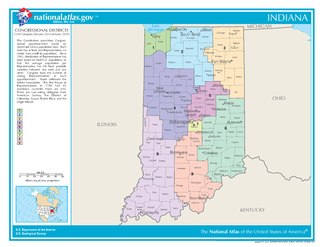
These are tables of congressional delegations from Indiana to the United States House of Representatives and the United States Senate.

Caleb Blood Smith was a United States Representative from Indiana, the 6th United States Secretary of the Interior and a United States District Judge of the United States District Court for the District of Indiana.
Charles Marion La Follette was an American lawyer and politician from Indiana. His great-grandfather was William Heilman, who was in the United States House of Representatives from Indiana. He served as a Republican in the United States House of Representatives during the 1940s and took part in the post-World War II Nuremberg Trials.

Albert Smith White was a United States Senator from Indiana, a United States Representative from Indiana and a United States District Judge of the United States District Court for the District of Indiana.

Indiana has nine congressional districts. They were last redrawn after the 2010 census and took effect in 2013, following the 2012 elections. For a history of who has served in each district, see United States congressional delegations from Indiana§House of Representatives.
Indiana's 10th congressional district was a congressional district for the United States House of Representatives in Indiana. It encompassed roughly the "Old City Limits" of Indianapolis from 1983-2003. The district was re-drawn after the 1980 census and eliminated when Indiana's representation in the House of Representatives fell from 10 to nine after the 2000 Census.

Stanton Judkins Peelle was a United States Representative from Indiana and an Judge and Chief Justice of the Court of Claims.

William Ellis Niblack was a U.S. Representative from Indiana.
James Hughes was a United States Representative from Indiana and a Judge of the Court of Claims.

The 2004 congressional elections in Indiana were elections for Indiana's delegation to the United States House of Representatives, which occurred along with congressional elections nationwide on November 2, 2004. Republicans held a majority of Indiana's delegation, 6-3, before the elections. The only incumbent to lose re-election was Democrat Baron Hill, losing to Republican Mike Sodrel in the 9th district.

The 1980 United States Senate election in Indiana took place on November 4, 1980, along with elections to the United States Senate in other states as well as the presidential election, elections to the United States House of Representatives and various state and local elections. Incumbent Democratic U.S. Senator Birch Bayh ran for a fourth term, but was defeated by Republican nominee, U.S. Representative Dan Quayle.

The 1998 congressional elections in Indiana were elections for Indiana's delegation to the United States House of Representatives, which occurred along with congressional elections nationwide on November 3, 1998. Republicans held a majority of Indiana's delegation over the Democrats, 6-4. Representatives were elected using the U.S. congressional districts based on the 1990 U.S. Census.

The 1996 congressional elections in Indiana were elections for Indiana's delegation to the United States House of Representatives, which occurred along with congressional elections nationwide on November 5, 1996. Republicans held a majority of Indiana's delegation over the Democrats, 6-4. Representatives were elected using the U.S. congressional districts based on the 1990 U.S. Census.

The 2000 congressional elections in Indiana were elections for Indiana's delegation to the United States House of Representatives, which occurred along with congressional elections nationwide on November 7, 2000. Republicans held a majority of Indiana's delegation over the Democrats, 6-4. This was the last time Representatives were elected using the U.S. congressional districts based on the 1990 U.S. Census.

The newly-created state of Indiana elected its sole member of the U.S. House of Representatives in August 1816, in advance of statehood, to represent Indiana's at-large congressional district.

The 1982 United States Senate election in Indiana was held on November 2, 1982. Incumbent Republican United States Senator Richard Lugar faced Democratic United States Representative Floyd Fithian in the general election. Lugar won with a margin of 53% of the vote, compared to Fithian's 46%.

The 2016 United States Senate election in Indiana was held on November 8, 2016, to elect a member of the United States Senate to represent the State of Indiana, concurrently with the 2016 U.S. presidential election, as well as other elections to the United States Senate in other states and elections to the United States House of Representatives and various state and local elections.

The 1876 United States presidential election in Indiana took place on November 7, 1876, as part of the 1876 United States presidential election. Indiana voters chose 15 representatives, or electors, to the Electoral College, who voted for president and vice president.
This page is based on this
Wikipedia article Text is available under the
CC BY-SA 4.0 license; additional terms may apply.
Images, videos and audio are available under their respective licenses.










